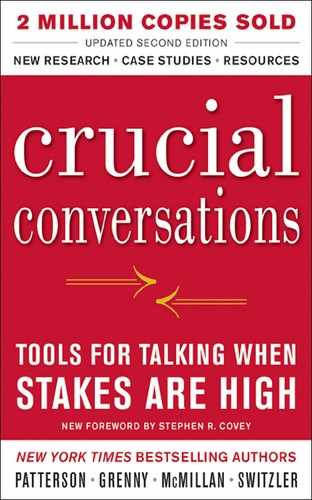TWO LEVERS
Over the years, people often tell us that the principles and skills contained in this book have helped them a great deal. But how? In what way can the printed word lead to important changes?
After watching people at home and at work, as well as interviewing them, we’ve learned that some people make progress by picking one skill that they know will help them get to dialogue in a current crucial conversation. But others focus less on skills and more on principles. For example, here are two high-leverage ways of getting started with increasing your capacity to get to dialogue by becoming more conscious of these two key principles.
Learn to Look. The first lever for positive change is Learn to Look. That is, people who improve their dialogue skills continually ask themselves whether they’re in or out of dialogue. This alone makes a huge difference. Even people who can’t remember or never learned the skills of STATE or AMPP, etc., are able to benefit from this material by simply asking if they’re falling into silence or violence. They may not know exactly how to fix the specific problem they’re facing, but they do know that if they’re not in dialogue, it can’t be good. And then they try something to get back to dialogue. As it turns out, trying something is better than doing nothing.
So remember to ask the following important question: “Are we playing games or are we in dialogue?” It’s a wonderful start.
Many people get additional help in learning to look from their friends. They go through training as families or teams. As they share concepts and ideas, they learn a common vocabulary. This shared way of talking about crucial conversations helps people change.
Perhaps the most common way that the language of dialogue finds itself into everyday conversation is with the expression, “I think we’ve moved away from dialogue.” This simple reminder helps people catch themselves early on, before the damage is severe. As we’ve watched executive teams, work groups, and couples simply go public with the fact that they’re starting to move toward silence or violence, others often recognize the problem and take corrective action. “You’re right. I’m not telling you what needs to be said,” or “I’m sorry. I have been trying to force my ideas on you.”
Make It Safe. The second lever is Make It Safe. We’ve suggested that dialogue consists of the free flow of meaning and that the number one flow stopper is a lack of safety. When you notice that you and others have moved away from dialogue, do something to make it safer. Anything. We’ve suggested a few skills, but those are merely a handful of common practices. They’re not immutable principles. To no one’s surprise, there are many things you can do to increase safety. If you simply realize that your challenge is to make it safer, nine out of ten times you’ll intuitively do something that helps.
Sometimes you’ll build safety by asking a question and showing interest in others’ views. Sometimes an appropriate touch (with loved ones and family members—not at work where touching can equate with harassment) can communicate safety. Apologies, smiles, even a request for a brief “time out” can help restore safety when things get dicey. The main idea is to Make It Safe. Do something to make others comfortable. And remember, virtually every skill we’ve covered in this book, from Contrasting to Priming, offers a tool for building safety.
These two levers form the basis for recognizing, building, and maintaining dialogue. When the concept of dialogue is introduced, these are the ideas most people can readily take in and apply to crucial conversations. Now let’s move on to a discussion of the rest of the principles we’ve covered.
